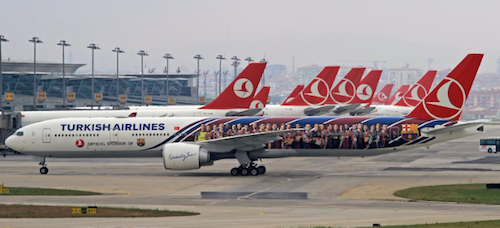Turkish Airlines forecasts 500-strong fleet

Turkish Airlines’ Vice President for Marketing and Sales in Central Europe Fatih Cığal said that within the scope of the 2023 macro targets, the company sees itself becoming one of the world’s five largest airlines operating 500 passenger and cargo aircraft.
Çıgal, who attended the events held in Zurich for the 50th anniversary of THY’s presence in Switzerland, has been evaluating the company’s objectives in Switzerland and the world.
Cığal stressed the importance of the Swiss market, where the company carries around 700,000 passengers per year with 64 flights every week.
Cığal stated that the carrier’s priority objective is to create an air bridge to increase trade between countries, with flights connecting Istanbul and major Swiss cities around the clock.
Çığal also mentioned the importance the company’s cargo division Turkish Cargo puts on the Swiss market. Airport Haber quotes Çığal saying: “We have been able to deliver our customers’ products safely and as soon as possible to the point they want in Turkey and in Switzerland on the same day.”
Çığal pointed out that Istanbul Atatürk Airport was unable to reach the frequency numbers they requested because of the limited capacity and said they were excitedly waiting for the opening of the third airport.
Çığal shared the knowledge that they aim to increase the annual passenger capacity in Switzerland by 2 times in the next 5 years to around 1.5 million with the opening of the new airport in Istanbul.
„Our 2023 macro target is to be one of the world’s five largest airlines operating with 500 passengers and cargo aircraft, Çığal said. „If we reach this goal, we will probably be the airline with the largest number of passengers in Europe and the largest number of seats. From the beginning of 2017 until now we have the largest seat capacity in Europe between national flag carriers or full-service airlines. If you also count low-cost carriers (Easyjet and Ryanair), we are third.”
As of April 2017, the company‘s fleet consisted of 341 aircraft in service, and 174 on order. Recently, media reports have surfaced talking about the possible acquisition of eight Boeing 747i aircraft.
Source – AeroTime

